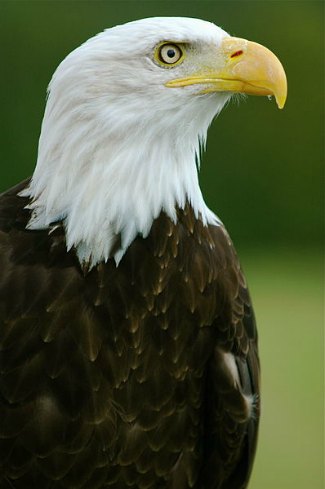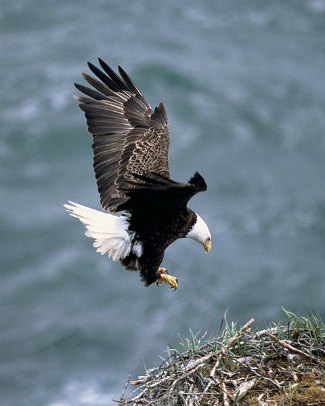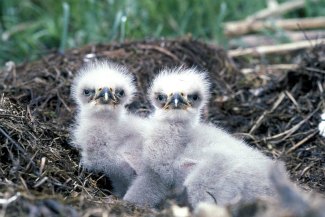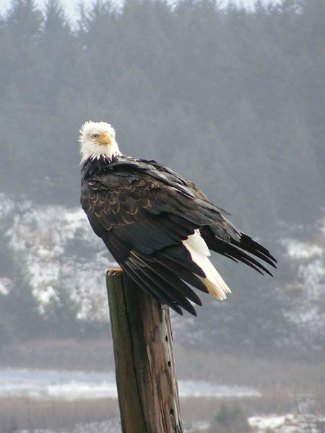Bald Eagle - Haliaeetus leucocephalus
By Paul Friel, CC-BY-2.0, via Wikimedia Commons
Family: Accipitridae
Genus: Haliaeetus
Species: H. leucocephalus
Bald Eagles may be the most recognized eagles in North America with their characteristic white head and tail, dark brown body, and yellow beak. They are sister species to Haliaeetus albicilla (White-Tailed Eagle) of Eurasia, occupying the same ecological niche in their respective ecosystems. They are also part of a clade including H. albicilla, H. leucoryphus (Pallas's Fish Eagle), and H. pelagicus (Steller's Sea Eagle). Bald Eagles are the national bird of the United States of America.
Physical Description:
Bald Eagles have a dark brown body and wings. They head and tail are white and are the same length when the bird reaches full maturity. The eyes, cere, beak, legs, and feet are yellow, and the claws are black.
Juveniles acquire their adult plumage after 4-5 years, but until then they closely resemble Aquila chrysaetos (Golden Eagle) with dark brown, mottled coloring. There are usually white patches on the juveniles where the wings meet the body, called axillars, or pits. The tail is dark brown to dirty-white.
Bald Eagle calls are weak, high-pitched whistles. The calls shriller and harsher in juveniles than in adults. Listen to a recording.
The average lifespan of Bald Eagles depends on their environment. In the wild it is 28 years, but in captivity, an eagle may live as long as 36 years. One captive eagle in New York State, USA lived to almost 50 years.
Size:
Length: 70-90 cm
Wingspan: 1.6-2.4 m
Weight: 2.5-6.3 kg
Habitat and Distribution:
Bald Eagles live around permanent sources of water such as reservoirs, lakes, and rivers, where there is a supply of fish. They prefer places with sites where they can perch, roost, and nest, which are usually trees or snags.
They are distributed throughout the lower 48 states of the USA and across Canada from 68°N to 23°N, 0-2,000 meters above sea level. They live year-round along the Pacific Coast and are particularly common in British Columbia and Alaska, along with the upper Mississippi River during the winter. They gather in large numbers where there are concentrations of food, such as salmon runs—at the Chilkat River, Alaska, over 3,000 eagles have been known to congregate as chum salmon swim up the river before it freezes. There are an estimated 300,000 individuals over 10,000,000 km².
By Dave Menke, Public Domain, via Wikimedia Commons
Diet and Hunting:
Their main diet consists of fish, particularly salmon, but they will also eat water birds, small mammals, snakes, carrion, and even human garbage. They regurgitate the indigestible parts of their food, including hair, feathers, and bone. In the winter they get most of their food by hunting ducks, searching for dead animals, and scavenging for fish during the fishes' spawning season.
Bald Eagles hunt by searching for their food from the air or from a perch, and are capable of seeing prey from a distance to up to one mile. They will swoop down to grab their prey, reaching speeds of up to 160 kph in a dive. They are able to swim by using their wings to paddle through the water and are known to chase after fish in shallow water with their beaks and talons. When hunting lagomorphs (rabbits and hares) they will hunt cooperatively with other eagles. Kleptoparsitism, stealing food from other animals, is common behavior.
By Dave Menke, Public Domain, via Wikimedia Commons
Reproduction:
The breeding season is from April-August in Alaska and Canada and October-April in the southern USA. Displays consist of aerial stunts including cartwheeling, where a pair locks their talons together and spins downward, pulling apart just before they hit the ground. They also rollercoaster, another kind of dive, but done by only one eagle—the displaying bird dives at a high speed and pulls out at the lowest point possible, soaring upwards to repeat the process. Bald Eagles are monogamous and usually find a new partner only if the former one dies.
Most nesting sites are close to water, often along shores or the banks of a river; one study found that 87% of sites were within 1.6 km of a water source. Nests are usually built on snags, old growth trees where there are open branches, in the forks of trees, or on cliffs. They can be 3-61 meters above the ground, and the amount of material that makes up a nest varies widely, from a sparse few sticks to huge, thick structures. More than one nest may be used per season, and eagles have been known to use the same nest for over 35 years.
A clutch of 1-3 eggs is laid in February-March, and both parents incubate the egg throughout the 34-40 day period. The eggs hatch asynchronously—one after the other, usually with a few days in between. The chicks are fed birds, fish, mammals, whatever is in the local area. The eaglets can fly by July and most of them head for the salmon spawning areas in August. They mature and are able to breed by age four.
Conservation:
Due to exposure to pesticides, such as DDT, which caused reproductive failure, along with other factors such as heavy metals in their diet and habitat loss, Bald Eagle populations sharply declined and the birds were declared endangered in the lower 48 states in 1967. They were upgraded to Threatened in 1995 and finally delisted in June, 2007. They are protected by the Migratory Bird Treaty Act and the Bald and Golden Eagle Protection Act, which prohibits the take, transport, sale, trade, import, export, possession of, and possession of products of the two eagles.
By Mary Lynn Stephenson, Public Domain, via Wikimedia Commons
Now, since they have a large range and population that appears to be increasing, Bald Eagles are listed as Least Concern by BirdLife International.
Taxonomy:
Bald Eagles form a species pair with Haliaeetus albicilla (White-Tailed Eagle). The species pair is thought to have split from other sea eagles in the Oligocene, around 24 million years ago, and then diverged in the North Pacific, with Bald Eagles moving into North America and the White-Tailed Eagle moving into Europe and parts of Asia. H. leucocephalus also forms a clade with H. albicilla, H. leucoryphus (Pallas's Fish Eagle), and H. pelagicus (Steller's Sea Eagle).
The "bald" in the Bald Eagles' name comes from the English word "piebald", which referred to its contrasting white head and dark body. Haliaeetus derives from the New Latin word for "sea eagle", which in turn comes from the Greek halo, meaning "sea", and aeetos, meaning eagle. Leucocephalus comes from the Greek leukos for "white" and kephale for "head".
Subspecies:
Two subspecies, H. l. leucocephalus and H. l. alascanus, used to be recognized. But when the "Southern" Bald Eagles were found in Canada and the "Northern" Bald Eagles were discovered flying into the southern US states and Mexico, they were no longer considered separate.
Other Names:
American Eagle, Gray-Backed Sea Eagle, White-Breasted Fish Eagle, White-Breasted Fish-Hawk, White-Headed Eagle, White Headed Fish Eagle, White-Headed Sea Eagle, Hvidhovedet Havørn (Danish), Amerikaanse Zeearend (Dutch), Valgepea-merikotkas (Estonian), Valkopäämerikotka (Finnish), Pygargue à tête blanche (French), Weißkopf-Seeadler (German), Skallörn (Icelandic), Iolair Maol (Irish), Aquila di mare testabianca (Italian), Hakutouwashi (Japanese), Baltagalvis erelis (Lithuanian), Hvithodehavørn (Norwegian), Águila cabeza blanca (Spanish), Vithövdad havsörn (Swedish), Eryr moel (Welsh).
Heraldry:
The Bald Eagle became the national bird of the USA on June 20, 1782. It appears on some of the country’s currency and on national seals, such as the Great Seal of the United States, which shows a Bald Eagle holding thirteen arrows and an olive branch.
Video of Bald Eagles:
References:
http://avibase.bsc-eoc.org/species.jsp?avibaseid=FED3756C12CF67FA
http://www.arkive.org/bald-eagle/haliaeetus-leucocephalus/
http://www.baldeagles.org/info
http://www.baldeagleinfo.com/
BirdLife International (2012) Species factsheet: Haliaeetus leucocephalus. Downloaded from http://www.birdlife.org on
06/01/2012.
http://www.bsc-eoc.org/research/speciesatrisk/baea/index.jsp?targetpg=biology
http://www.eagles.org/vu-study/biology/reproduction.php
http://www.enchantedlearning.com/subjects/birds/info/Eagle.shtml
http://esrp.csustan.edu/speciesprofiles/profile.php?sp=hale
Global Raptor Information Network. 2011. Species account: Bald Eagle Haliaeetus leucocephalus. Downloaded from
http://www.globalraptors.org on 01 Jun 2012
http://www.itis.gov/servlet/SingleRpt/SingleRpt?search_topic=TSN&search_value=175420
BirdLife International 2009. Haliaeetus leucocephalus. In: IUCN 2011. IUCN Red List of Threatened Species. Version 2011.1.
www.iucnredlist.org. Downloaded on 01 June 2012.
http://www.nwf.org/Wildlife/Wildlife-Library/Birds/Bald-Eagle.aspx
http://www.pwlf.org/baldeagle.htm
Ferguson-Lees, James, and Christie, David A. Raptors of the World. Houghton Mifflin Company, 2001.



